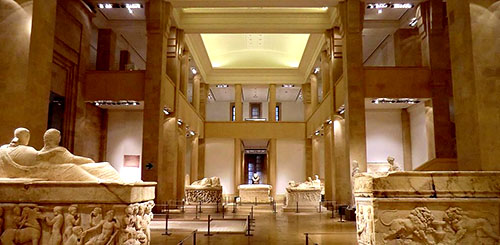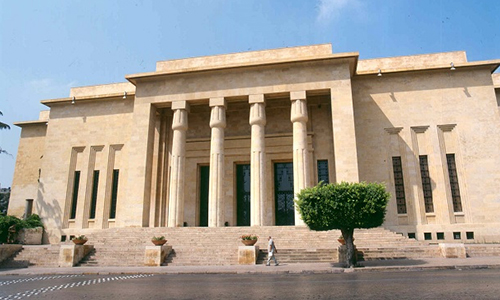Национальный музей в Бейруте, на трех этажах которого экспонируется более 1,8 тыс. объектов, охватывающих период с доисторических времён до эпохи Османской империи, открылся в 1942 году и с тех пор успел пережить многое. Во время гражданской войны, начавшейся в Ливане в 1975 году, здание пострадало от бомбардировок.
Национальный музей Бейрута вновь открыл свои двери — при экспертной поддержке Лувра — после двойного взрыва, прогремевшего в столице Ливана 4 августа 2021 года. Взрывная волна разрушила окна и двери музея и сильно повредила систему безопасности. Около 200 человек погибли тогда и более 6 тыс. были ранены в результате взрывов, вызвавших обрушение множества домов в городе.
В первые дни после трагедии Главное управление древностей при Министерстве культуры Ливана разработало план действий по восстановлению музея. Составить план помогли сотрудники отдела ближневосточных древностей и отдела архитектурного наследия и садов Лувра; к принятию экстренных мер приступили 31 августа 2020 г.
Первым делом здание и коллекции обезопасили, восстановив двери, окна и систему безопасности; французские специалисты также помогли устранить повреждения в административных помещениях и хранилищах отдела археологии.
Восстановление Национального музея Бейрута спонсировал Международный альянс по защите наследия в зонах конфликтов («Алиф»), выделивший для этого 175 000 USD. Всего «Алиф» поддержал в Бейруте 18 проектов общей стоимостью 2 300 000 USD, которые предусматривали принятие экстренных мер по стабилизации более 30 исторических зданий и восстановление памятников, культовых построек и культурных институций, в том числе Музея Сурсока (500 000 USD).
«На фоне кризиса, который переживает Ливан, выполнение этих работ в такие сжатые сроки — большой успех», — говорит руководитель главного управления по древностям Саркис аль-Хури. – «Совместный проект – это важная часть общей работы, которую мы ведем с Лувром и фондом „Алиф“». Музей также выложил в интернет новые виртуальные туры по своей коллекции.
Однако на техническое обслуживание во время второго этапа восстановления требуются дополнительные деньги. Для обеспечения долгосрочной работы музея, система кондиционирования воздуха которого на данный момент функционирует только на 30% мощности, требуется капитальный ремонт, стоимостью около 800 000 USD. Некоторые части здания, в том числе зал с мумиями 13 века, вентилируются резервными системами.
© Times of Ukraine

The National Museum in Beirut, on three floors of which more than 1.8 thousand objects are exhibited, covering the period from prehistoric times to the era of the Ottoman Empire, opened in 1942 and has gone through a lot since then. During the civil war that began in Lebanon in 1975, the building was damaged by bombing.
The National Museum of Beirut reopened its doors – with the expert support of the Louvre – after a double explosion in the Lebanese capital on August 4, 2021. The blast wave destroyed the museum’s windows and doors and severely damaged the security system. At least 200 people were killed and more than 6,000 were injured in explosions that caused the collapse of many houses in the city.
In the first days after the tragedy, the General Directorate of Antiquities under the Lebanese Ministry of Culture developed an action plan to restore the museum. The plan was helped by the staff of the Department of Middle Eastern Antiquities and the Department of Architectural Heritage and Gardens of the Louvre; the adoption of emergency measures began on August 31, 2020.
The first step was to secure the building and collections by restoring the doors, windows and security system; French specialists also helped repair damage to the administrative premises and storage facilities of the archeology department.
The restoration of the National Museum of Beirut was sponsored by the International Alliance for the Protection of Heritage in Conflict Areas (Alif), which allocated 175,000 USD for this. In total, Alif supported 18 projects in Beirut with a total value of 2,300,000 USD, which included the adoption of emergency measures to stabilize more than 30 historical buildings and the restoration of monuments, places of worship and cultural institutions, including the Sursok Museum (500,000 USD).
“Against the backdrop of the crisis that Lebanon is experiencing, the completion of these works in such a tight time frame is a great success,” says Sarkis al-Khouri, head of the General Directorate for Antiquities. – “The joint project is an important part of the common work that we are doing with the Louvre and the Alif Foundation.” The museum has also posted new virtual tours of its collection online.
However, additional money is required for maintenance during the second phase of rebuilding. To ensure the long-term operation of the museum, the air conditioning system of which is currently functioning at only 30% of its capacity, a major overhaul is required at a cost of about 800,000 USD. Parts of the building, including the 13th century mummy room, are ventilated by back-up systems.
© Times of Ukraine

